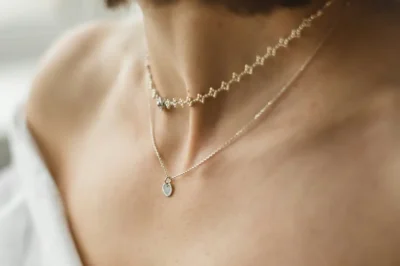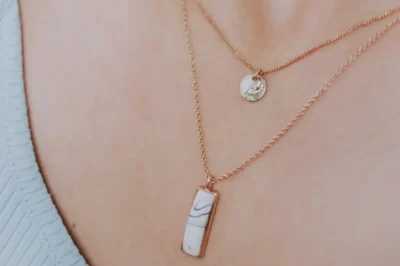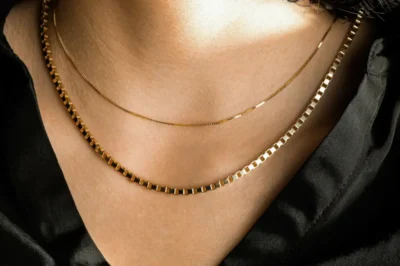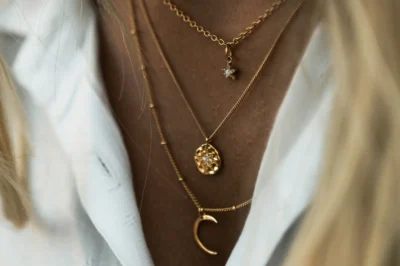Necklace layering has quickly become one of the most beloved styling techniques among jewelry enthusiasts, fashionistas, and diamond lovers alike. It allows you to transform a simple outfit into a show-stopping statement without much effort. But while it may look effortless, perfect necklace layering requires thought, strategy, and a keen eye for detail. In this ultimate guide, we’ll break down the golden rules, expert tips, and secrets that will help you master necklace layering like a pro.
Understanding the Basics of Necklace Layering
Before diving into the golden rules, it’s crucial to understand the foundational elements that make necklace layering successful. Think of it as learning the grammar before writing poetry—it sets you up for creativity with purpose.
Necklace Lengths and How They Work Together
Necklace length plays a pivotal role in layering. Knowing the standard lengths helps create visual harmony and prevents tangling:
- Choker (14–16 inches): Sits snugly around your neck. Ideal as a starting point in your layered set.
- Princess (17–19 inches): Usually falls near the collarbone. A versatile length for both casual and formal outfits.
- Matinee (20–24 inches): Slightly longer, resting between collarbone and bust. Perfect for layering over tops or dresses.
- Opera (28–36 inches): Dramatic and elegant, suitable for longer layered designs.
- Rope (over 36 inches): Can be looped multiple times or left long for a statement effect.
A successful layered look often combines short, medium, and long lengths to create dimension. For example, pairing a choker with a princess-length diamond chain and an opera-length pendant creates a cascading, elegant effect.
Types of Necklaces to Layer
Not all necklaces are created equal, and understanding which types work together is key:
- Chains: Classic and versatile. Gold or silver chains are staples in layering.
- Pendants: Add personality and focal points to your layered ensemble.
- Lockets: Perfect for a vintage touch and meaningful layering.
- Chokers: Provide a bold starting point and anchor your layers.
- Beaded Necklaces: Offer texture and color contrast, especially when paired with metallic chains.
The key is variety. Combining delicate chains with bold pendants or textured beads ensures each layer stands out while maintaining harmony.
Choosing the Right Metals and Colors
Mixing metals used to be a fashion faux pas, but modern styling encourages experimenting with gold, silver, rose gold, and even platinum. The secret lies in balance: choose one dominant metal and sprinkle accents of another. For instance:
- Gold chains with a small rose gold pendant.
- Silver layered with white gold for a sophisticated, monochromatic look.
Adding gemstones or diamonds into the mix can elevate your look without overwhelming it. Subtle hints of color in pendants or beads create visual interest.
The Golden Rules of Necklace Layering
Now that the basics are covered, it’s time to dive into the golden rules that ensure your necklace layers always look intentional and stylish.
Rule 1 – Start with a Statement Piece
Every great layered necklace look begins with a focal point. Whether it’s a dazzling diamond pendant, a vibrant gemstone, or a chunky chain, this piece sets the tone for the entire arrangement. Start with your favorite statement necklace and build layers around it with complementary lengths and textures.
Rule 2 – Play with Lengths and Proportions
Varying necklace lengths prevents your layers from tangling and creates a visual flow. As a rule of thumb:
- Shortest necklace at the top.
- Medium necklace in the middle.
- Longest necklace at the bottom.
Proportion is key: avoid placing two necklaces that sit at the exact same height, or they’ll compete instead of complementing each other.
Rule 3 – Balance Textures and Styles
Mixing textures is a fun way to add depth. Pair delicate chains with bold links, or smooth metal with beaded strands. For instance:
- A delicate diamond chain paired with a chunky gold chain.
- A silk cord necklace layered with a thin gold pendant chain.
Balancing styles keeps your layers interesting while maintaining elegance.
Rule 4 – Stick to a Cohesive Color Palette
Even if you mix metals, maintaining a cohesive color palette helps your necklaces look harmonious. If you’re mixing metals, add small elements of one color in another layer to tie everything together. This trick ensures your layered look appears curated, not accidental.
Rule 5 – Consider Neckline and Outfit
Your neckline plays a crucial role in how your layers sit. For example:
- V-neck tops: Highlight the center with a longer pendant.
- Crew necks: Start layering just above the neckline to prevent necklaces from disappearing.
- Off-shoulder tops: Chokers and short necklaces work best to accentuate your collarbones.
Always coordinate your outfit and layering plan together to enhance your overall look.
Rule 6 – Limit the Number of Necklaces
While layering is about abundance, overdoing it can look messy. A good rule of thumb is 3–5 necklaces, adjusting based on thickness and statement size. More than five layers can overwhelm your neckline unless each piece is extremely delicate.
Expert Tips for Diamond and Gemstone Necklace Layering
Layering diamonds and gemstones requires careful consideration to avoid a look that’s too flashy or clunky.
- Start small: Use one or two diamond pieces as accent layers before adding bold colored gemstones.
- Vary shapes and sizes: Round diamonds, baguette cuts, and teardrop pendants can create an elegant contrast.
- Mind sparkle placement: Place larger diamonds or gemstones lower in the layering sequence to create visual weight and balance.

Remember, diamonds and gemstones can be both understated and dramatic—layering them thoughtfully maximizes their beauty.
Layering for Different Occasions
Not all layers are suited for every situation. Here’s a guide to choosing your necklaces based on occasion:
Everyday Casual Looks
Keep it simple with delicate chains and small pendants. Stack a 16-inch chain with an 18-inch gemstone necklace for a chic office or coffee date look. Minimalism ensures your layers enhance rather than distract.
Evening Glam & Special Events
For parties or galas, mix diamonds, gemstones, and metallic chains to create sparkle and drama. Consider combining one statement diamond necklace with two medium-length gold chains, or add a long opera-length pendant for a luxe look.
Seasonal Trends
Fashion trends influence layering styles:
- Spring/Summer: Light, colorful beads and layered charms.
- Fall/Winter: Chunkier chains and mixed metals for texture.
- Holiday events: Diamonds and gemstones for sparkle and festive flair.
Keeping an eye on trends allows you to refresh your layered necklaces seasonally.
Common Necklace Layering Mistakes to Avoid
Even seasoned jewelry lovers can stumble when layering. Avoid these pitfalls:
- Tangling chains: Start with longer chains at the bottom and shorter chains at the top.
- Clashing metals or styles: Stick to one dominant metal or cohesive theme.
- Overcrowding: Avoid placing too many statement pieces together.
- Ignoring neckline considerations: Always consider the top you’re wearing as part of your layering plan.
Maintenance Tips for Layered Necklaces
Layered necklaces require care to maintain their beauty:
- Prevent tangles: Hang necklaces separately or use layered necklace organizers.
- Cleaning tips: Use a soft cloth for metals; mild soap and water for gemstones. Avoid harsh chemicals that can damage delicate layers.
- Storage: Store flat or hanging to prevent kinks and knots.
Proper maintenance ensures your layered necklaces look polished and last longer.
Personalizing Your Necklace Layers
The beauty of necklace layering lies in personalization. Here are creative ways to make your layers truly yours:
- Mix meaningful charms: Add lockets or personalized pendants to reflect your story.
- Play with asymmetry: Uneven lengths or unexpected charms can make a layered look modern and edgy.
- Incorporate heirlooms: Blend vintage and contemporary pieces for a timeless yet fresh style.

Layering allows your jewelry to tell a story—don’t be afraid to experiment and let your personality shine through.
Conclusion
Mastering necklace layering transforms your jewelry game from simple to spectacular. By following the golden rules—starting with a statement piece, varying lengths, balancing textures, and respecting proportion—you can create looks that are elegant, stylish, and uniquely yours. Remember to consider your outfit, occasion, and personal style, and don’t shy away from mixing metals, diamonds, and gemstones to add dimension and interest.






